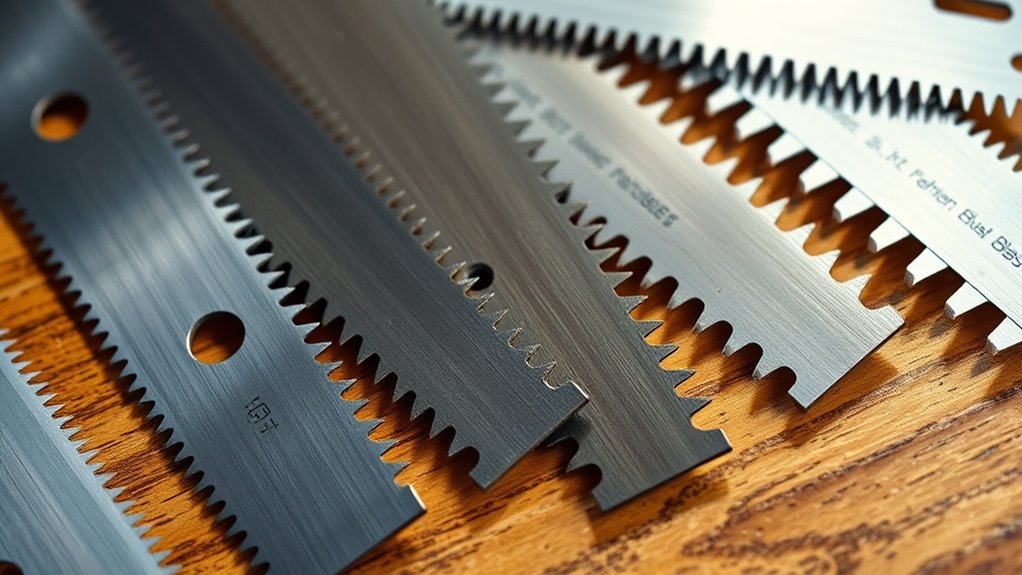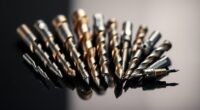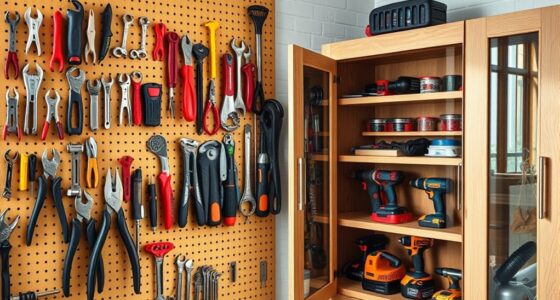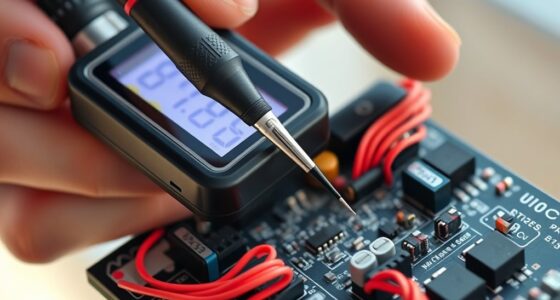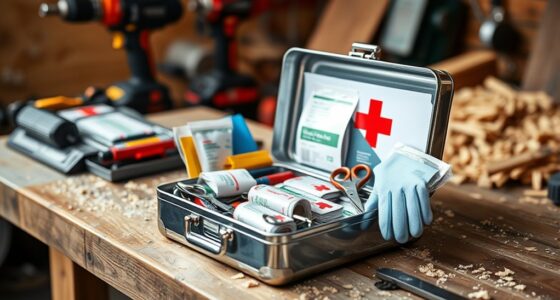Understanding saw blade types helps you choose the right tool for each task. You’ll find circular blades, table saw blades, and miter saw blades designed for different cuts and materials. Band, reciprocating, and specialty blades are perfect for complex shapes or tougher materials. Knowing the differences in blade materials, like carbide or high-speed steel, guarantees safety and better results. Keep exploring to discover more tips on selecting and maintaining the perfect blades for your projects.
Key Takeaways
- There are various saw blade types, including circular, table, miter, band, reciprocating, and jig saw blades, each designed for specific cuts.
- Blade materials such as high-speed steel, carbide-tipped, bi-metal, and diamond influence durability and suitability for different materials.
- Blade tooth configurations and coatings affect cutting precision, speed, and the type of material that can be cut effectively.
- Abrasive and specialty blades are designed for grinding, finishing, or cutting tough surfaces like metal, stone, or composites.
- Proper blade selection and maintenance are essential for safety, efficiency, and achieving high-quality cuts.
Circular Saw Blades
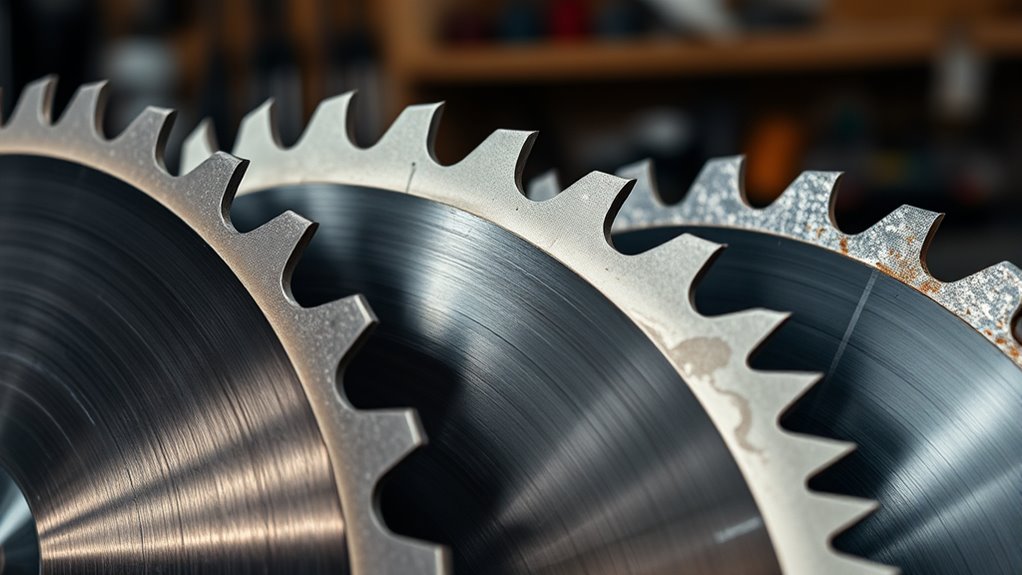
Have you ever wondered what makes a circular saw blade suitable for a specific cut? The key factors include blade sharpening and safety precautions. A sharp blade ensures clean, precise cuts and reduces the risk of kickback or binding. Regular blade sharpening maintains cutting efficiency and prolongs the blade’s lifespan. When handling or replacing blades, always follow safety precautions, like wearing gloves and eye protection, to avoid injuries. Properly maintained blades not only perform better but also keep you safer during operation. Remember, using the right blade for the material and ensuring it’s sharp can prevent accidents and improve your work quality. Keeping blades clean and free of debris is also essential for optimal performance and safety. Blade maintenance is crucial for ensuring *ideal* performance.
Table Saw Blades

When choosing a table saw blade, you’ll notice a range of diameter options that suit different projects. The tooth configurations vary to handle precise cuts or faster material removal, while the materials and coatings influence durability and performance. Understanding these aspects helps you pick the right blade for your woodworking needs. Additionally, selecting a blade with appropriate technology can significantly improve cut quality and efficiency.
Blade Diameter Options
Are you aware of the common blade diameters available for table saws? Blade diameter options vary, affecting cutting capacity and safety considerations. Smaller blades, like 8 inches, are ideal for precise cuts, while larger blades, such as 12 inches, handle thicker materials. Here’s a quick overview:
| Blade Diameter | Typical Use | Safety Tips |
|---|---|---|
| 8 inches | Fine woodworking | Keep guard in place |
| 10 inches | General purpose | Use proper blade guard |
| 12 inches | Heavy-duty cuts | Ensure stable setup |
| 14 inches | Industrial applications | Check for proper mounting |
Choosing the right size guarantees safety and peak performance. Always follow safety guidelines tailored to your blade diameter to prevent accidents. For more detailed information, refer to Patchology.ORG.
Tooth Configurations Variations
Tooth configurations considerably influence how a table saw blade performs, determining its suitability for different cutting tasks. Your choice of tooth configuration affects the cutting edge’s shape, spacing, and size, which directly impacts efficiency and finish quality. For example, a combination tooth configuration offers a smooth cut for crosscutting, while a raker tooth provides stability for ripping. Alternating tooth setups, like ATB (Alternate Top Bevel), produce cleaner edges, making them ideal for fine woodworking. Fewer teeth mean faster cuts but rougher edges, whereas more teeth create smoother finishes but cut slower. Understanding these variations helps you select a blade whose tooth configuration aligns with your project needs, ensuring optimal performance and precise results with every cut.
Material and Coatings
Choosing the right material and coatings for your table saw blade is essential for durability, cutting performance, and the materials you’re working with. High-quality blades often feature carbide tips or steel bodies, providing longevity and precision. For tougher materials, diamond blades are your best option, especially in cutting stone or concrete. Abrasive coatings, like Teflon or ceramic, reduce heat buildup and improve lifespan. Here’s a quick overview:
| Material/Coating | Best For | Benefits |
|---|---|---|
| Carbide Tips | Wood, plastics | Sharp, long-lasting |
| Steel Body | General use | Cost-effective, durable |
| Diamond Coatings | Stone, concrete | Extreme hardness, precision |
| Abrasive Coatings | Metal, composites | Reduce heat, extend blade life |
| Teflon Coatings | Softwood, plastics | Reduce friction, cleaner cuts |
Additionally, selecting blades that align with AI in Education innovations can support more precise and efficient woodworking training programs.
Miter Saw Blades
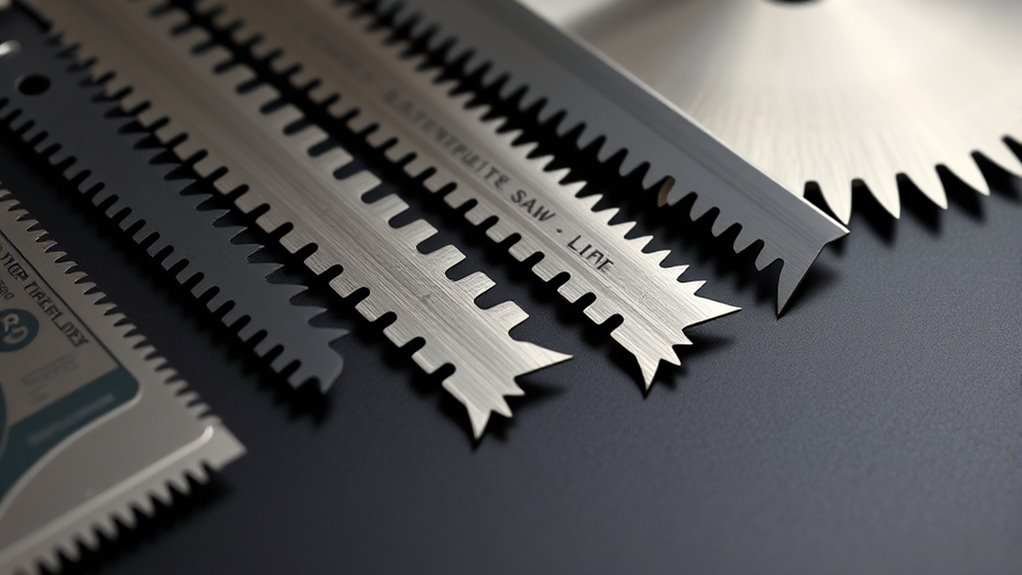
Ever wondered what makes a miter saw blade ideal for precise crosscuts and angled cuts? It’s all about the design and sharpness of the blade. Miter saw blades are specially engineered to deliver excellent crosscut precision, ensuring smooth, accurate cuts every time. To achieve this, keep in mind these key features:
- Tooth count – higher tooth counts provide cleaner cuts for fine work.
- Blade diameter – larger diameters increase cutting capacity and stability.
- Tooth geometry – beveled or alternate top bevels improve cut quality.
- Material coating – helps reduce friction and prolongs blade life.
Choosing the right miter saw blade based on these factors guarantees you get the best performance for angled and crosscut projects.
Band Saw Blades
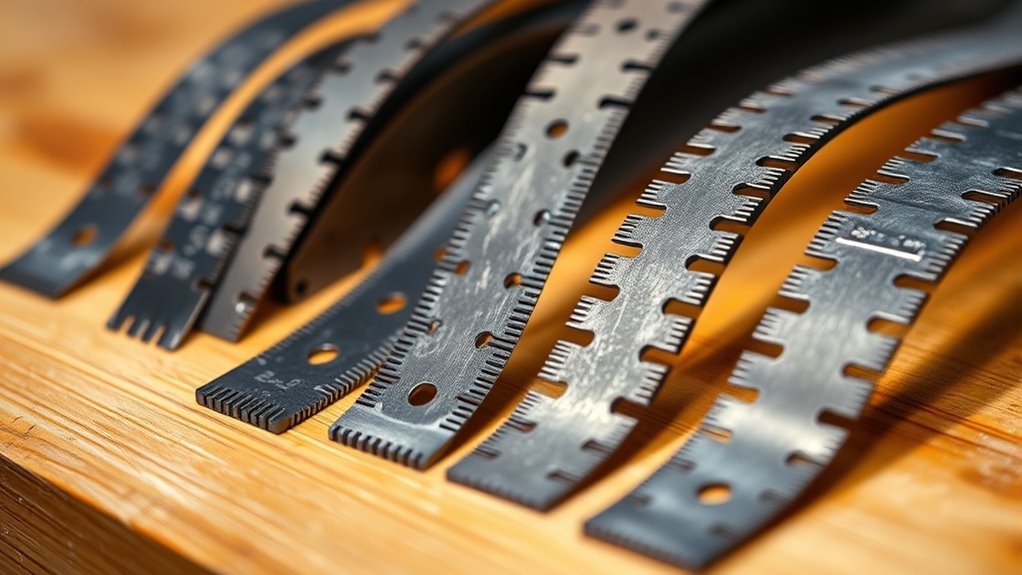
Like miter saw blades, band saw blades are designed for specific cutting tasks, but they excel in versatility and continuous operation. You’ll find them ideal for cutting curves, irregular shapes, and large stock pieces. To keep your band saw performing well, regular blade sharpening is essential; dull blades can cause rough cuts and safety hazards. When sharpening, follow manufacturer guidelines to avoid damaging the blade or compromising safety. Always observe safety precautions, such as unplugging the saw before replacing or maintaining the blade, wearing protective gear, and handling blades carefully to prevent injury. Proper maintenance not only enhances cutting accuracy but also extends your blade’s lifespan. Additionally, understanding the different blade types used for various materials can improve your cutting results significantly. By staying diligent with blade sharpening and safety, you ensure efficient, safe, and precise operations.
Reciprocating Saw Blades
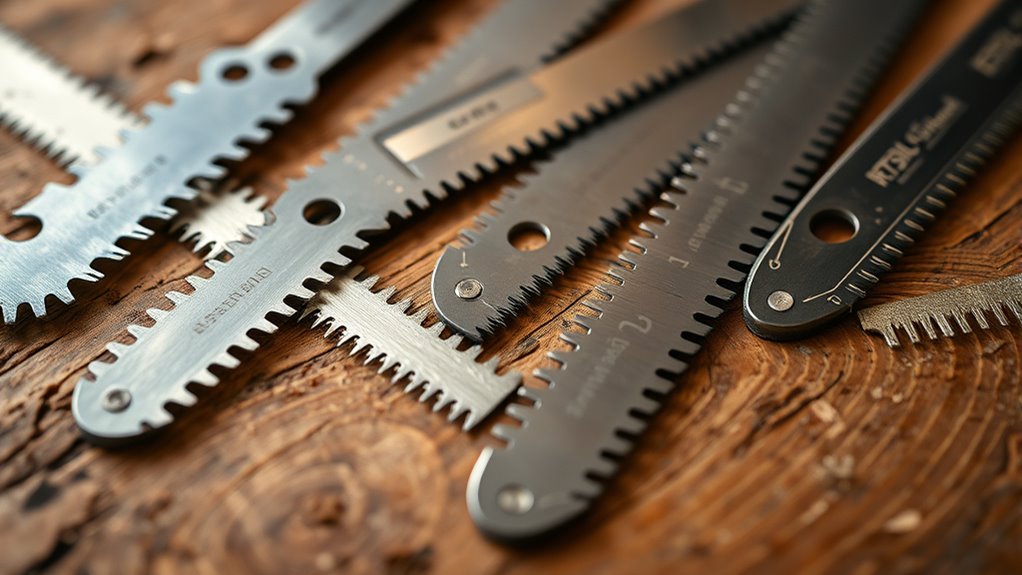
Are you aware of the variety of reciprocating saw blades designed for different materials and cutting tasks? These blades come in various types tailored for wood, metal, plastic, or demolition work. To get the best performance and safety, consider these points:
- Choose the right blade for your material to prevent dulling and ensure efficient cuts.
- Regularly inspect and blade sharpen when dull to maintain cutting power and safety.
- Always follow safety precautions like wearing gloves and eye protection during use.
- Replace blades promptly if they show signs of damage or excessive wear to avoid accidents.
- Utilizing AI-powered tools can assist in selecting the most suitable blade for specific tasks, enhancing efficiency and safety.
Using the correct reciprocating saw blade and maintaining it properly helps you work safely and effectively. Remember, blade sharpening extends blade life and improves cutting precision.
Jig Saw Blades
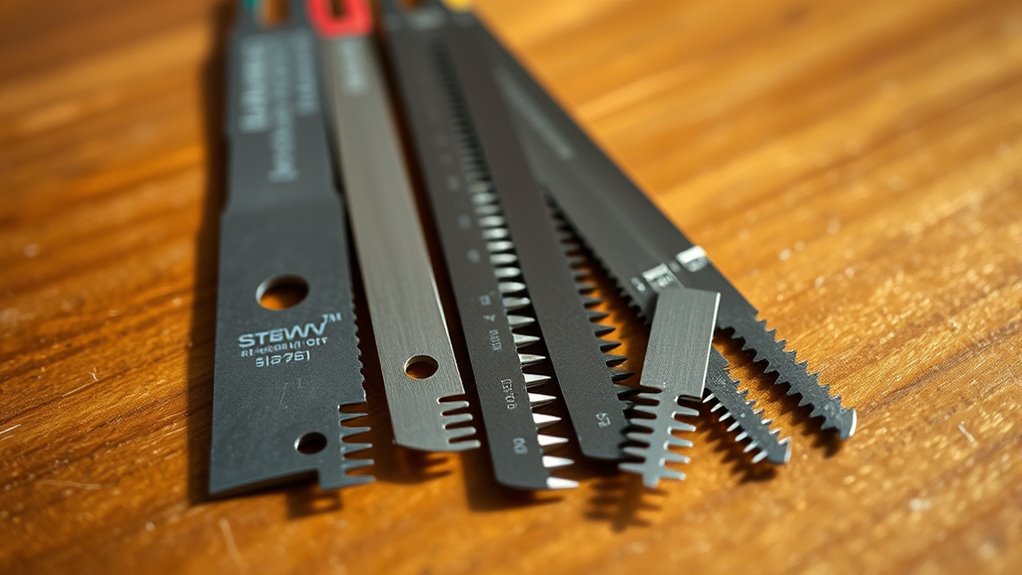
Jig saw blades come in various materials, each designed for different cutting tasks. You’ll want to choose the right blade based on whether you’re working with wood, metal, or plastic. Understanding these material options helps you select the most effective blade for your project. Additionally, selecting the appropriate blade can enhance safety and efficiency during cutting operations, aligning with best practices in ethical hacking to identify and mitigate risks effectively.
Blade Material Variations
Choosing the right blade material is crucial for achieving clean cuts and prolonging your jig saw’s lifespan. Different materials offer varying durability and cutting efficiency. For example, high-speed steel blades excel in blade sharpening and last longer on softer materials. Carbide-tipped blades are ideal for tougher materials but require extra safety precautions due to their hardness. Bi-metal blades combine flexibility with durability, making them versatile. Finally, diamond blades are best for very hard surfaces but are more expensive. Selecting the appropriate blade material can also influence the effectiveness of air filtration, especially when cutting materials that produce fine dust and particles.
Suitable Cutting Materials
Selecting the appropriate cutting materials for your jig saw blades depends on the type of work you plan to do. Different blades excel with specific materials, whether you’re aiming for smooth cuts, abrasive finishes, or decorative patterns. For soft woods, use blades with fine teeth for precision. Harder materials like plastics or metals require more durable blades. Here’s a quick guide:
| Material | Recommended Blade Type |
|---|---|
| Soft woods | Fine-tooth blades |
| Hard plastics/metal | Bi-metal or carbide-tipped blades |
| Composite materials | Special blades designed for abrasive finishes |
| Decorative work | blades with varied teeth for intricate patterns |
Choosing the right blade guarantees cleaner cuts and better results. Additionally, proper blade maintenance can extend the lifespan and performance of your jig saw blades.
Abrasive Blades and Discs

Abrasive blades and discs are essential tools for cutting, grinding, and finishing a variety of materials, including metal, stone, and concrete. When selecting abrasive blades, consider these factors:
- Material compatibility – verify your disc matches the material you’re working on.
- Grit size – finer grits for smooth finishes, coarser for aggressive material removal.
- Disc diameter – choose the right size for your tool and task.
- Disc type – from grinding to cutting, select the appropriate abrasive blade for your needs.
- Proper selection and use of abrasive blades are guided by divorce guidance, ensuring safety and optimal performance.
Specialty and Carbide-Tipped Blades
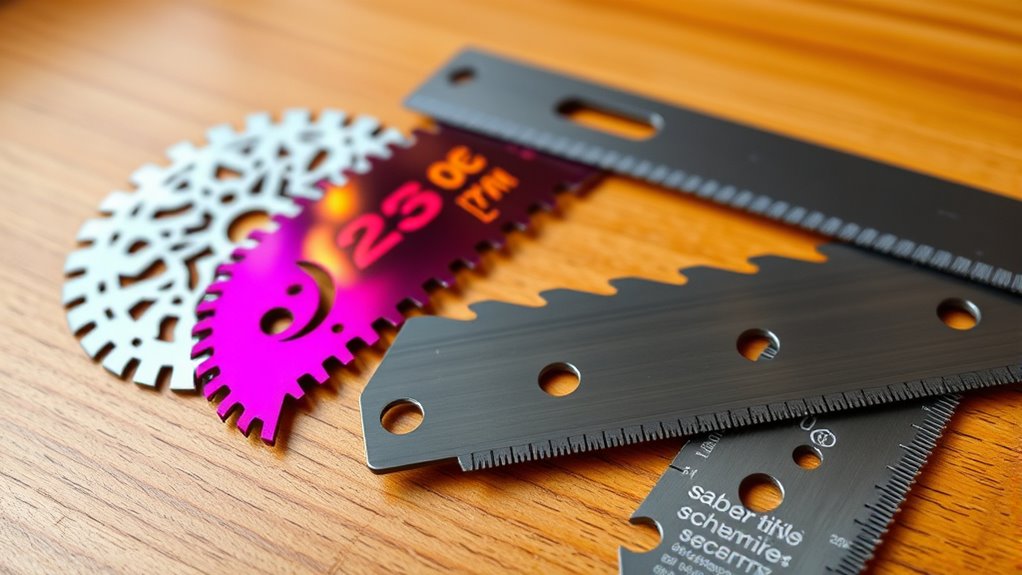
Specialty and carbide-tipped blades are known for their exceptional durability and long-lasting performance. They’re designed to handle tougher materials without wearing out quickly. Knowing which blades suit your material makes certain you get the most efficient and reliable cuts. Incorporating proper storage and maintenance can further extend the lifespan of these blades and ensure optimal performance over time.
Durability and Longevity
When it comes to durability and longevity, specialty and carbide-tipped saw blades stand out for their ability to withstand heavy use and maintain sharpness over time. Their resilience depends on several factors:
- Blade sharpening: These blades can often be resharpened multiple times, extending their lifespan.
- Cutting performance: They resist dulling, even with frequent use, ensuring consistent cuts.
- Corrosion resistance: The tough coatings help prevent rust, keeping blades in good condition longer.
- Material toughness: Carbide tips endure high temperatures and friction, reducing wear and tear.
- Proper maintenance: Regular cleaning and correct storage can further enhance their longevity and performance.
Together, these features make specialty and carbide-tipped blades a reliable choice for demanding tasks, offering you extended service life and reduced replacement costs.
Material Compatibility
Because of their precise design, carbide-tipped and specialty saw blades are compatible with specific materials, ensuring ideal cutting performance. When selecting abrasive wheels or blades, you need to take into account the material you’re working with. Carbide tips offer significant advantages, such as increased hardness and wear resistance, making them ideal for cutting tough materials like metal, hardwood, or composite materials. Specialty blades are engineered for specific applications, like cutting plastics or laminates, and are designed to optimize performance with those materials. Proper abrasive wheel selection ensures you match the blade’s capabilities to the material’s properties, preventing damage and ensuring clean cuts. Additionally, understanding material compatibility can help you select the most effective blade type, leading to better results and longer tool life. By choosing the right blade type based on material compatibility, you maximize efficiency, blade life, and safety during your cutting tasks.
Metal Cutting Blades

Metal cutting blades are essential tools designed specifically to cut through various types of metal with precision and efficiency. To keep them performing well, you need to focus on blade sharpening regularly, ensuring clean cuts and prolonging blade life. When using these blades, always follow safety precautions, like wearing gloves and eye protection, to prevent injuries. Here are key tips: 1. Inspect blades for damage before each use. 2. Sharpen blades when you notice decreased cutting performance. 3. Use the correct blade for the specific metal you’re working with. 4. Always follow manufacturer guidelines for safe operation. Proper maintenance of airless paint sprayers also helps ensure optimal performance and safety during projects.
Plastic and Composite Material Blades

Plastic and composite material blades are specially designed to cut through lightweight, non-metallic materials with ease and accuracy. These blades often feature resin-based blades or fiber-reinforced blades, which provide durability and clean cuts. They excel at working with plastics, fiberglass, and composite panels without causing splintering or melting. Ensuring the trustworthiness of AI tools in manufacturing processes can help optimize blade performance and safety.
| Blade Type | Ideal Material |
|---|---|
| Resin-based blades | Plastics, acrylics |
| Fiber reinforced blades | Fiberglass, composites |
| Carbide-tipped blades | Resin composites |
| Diamond blades | Very hard plastics |
| Thin-kerf blades | Lightweight plastics |
Choosing the right blade guarantees precision and prolongs tool life, making them essential for accurate, clean cuts in lightweight materials.
Frequently Asked Questions
How Do I Choose the Right Blade for My Specific Project?
When choosing the right blade for your project, consider the blade material and size. Pick a blade made from durable materials like carbide for tougher cuts, and match the blade size to your saw and the material you’re working with. Smaller blades are ideal for detailed work, while larger ones handle bigger cuts. Always select a blade that fits your saw and suits the material to guarantee safe, efficient cutting.
What Safety Precautions Should I Follow When Using Different Saw Blades?
When using different saw blades, you should always prioritize safety. Wear appropriate safety gear like goggles and ear protection, and make sure blade guards are in place and functioning properly. Keep your hands away from the blade, and never force the saw. Before starting, inspect the blade for damage. Following these precautions helps prevent accidents and guarantees safe, effective cutting every time.
How Often Should I Replace or Sharpen Saw Blades?
You should replace or sharpen your saw blades based on their blade maintenance and sharpening schedule. Typically, sharpen blades when you notice rough cuts, increased effort, or burning wood. For frequent use, plan to sharpen every few uses or after cutting hard materials. Replace blades when they’re excessively worn, cracked, or damaged beyond repair. Regular blade maintenance ensures peak performance and safety, saving you time and effort in the long run.
Can I Use General-Purpose Blades for Specialized Materials?
Using general-purpose blades on specialized materials is like trying to fit a square peg in a round hole. They often lack the blade durability needed for tougher materials and may not offer proper material compatibility. This can lead to quicker dulling, poor cuts, and even safety hazards. For best results, always choose blades designed specifically for your material to guarantee precision, efficiency, and safety.
What Are the Environmental Considerations for Disposing of Used Blades?
When disposing of used blades, you should consider recycling options to reduce environmental impact. Some blades contain hazardous waste components like chemicals or metals, so you need to follow local regulations for safe disposal. Check if your community offers special recycling programs for metal or hazardous waste. Never throw blades in regular trash, as they can pose safety hazards and environmental risks. Proper disposal helps protect the environment and complies with legal requirements.
Conclusion
Knowing the different saw blade types can boost your cutting precision and safety. Did you know that choosing the right blade can increase your cutting speed by up to 40%? Whether you’re working with wood, metal, or plastic, understanding each blade’s purpose helps you get the job done efficiently. So next time you pick a saw blade, remember how the right choice can make all the difference in your project’s success.
